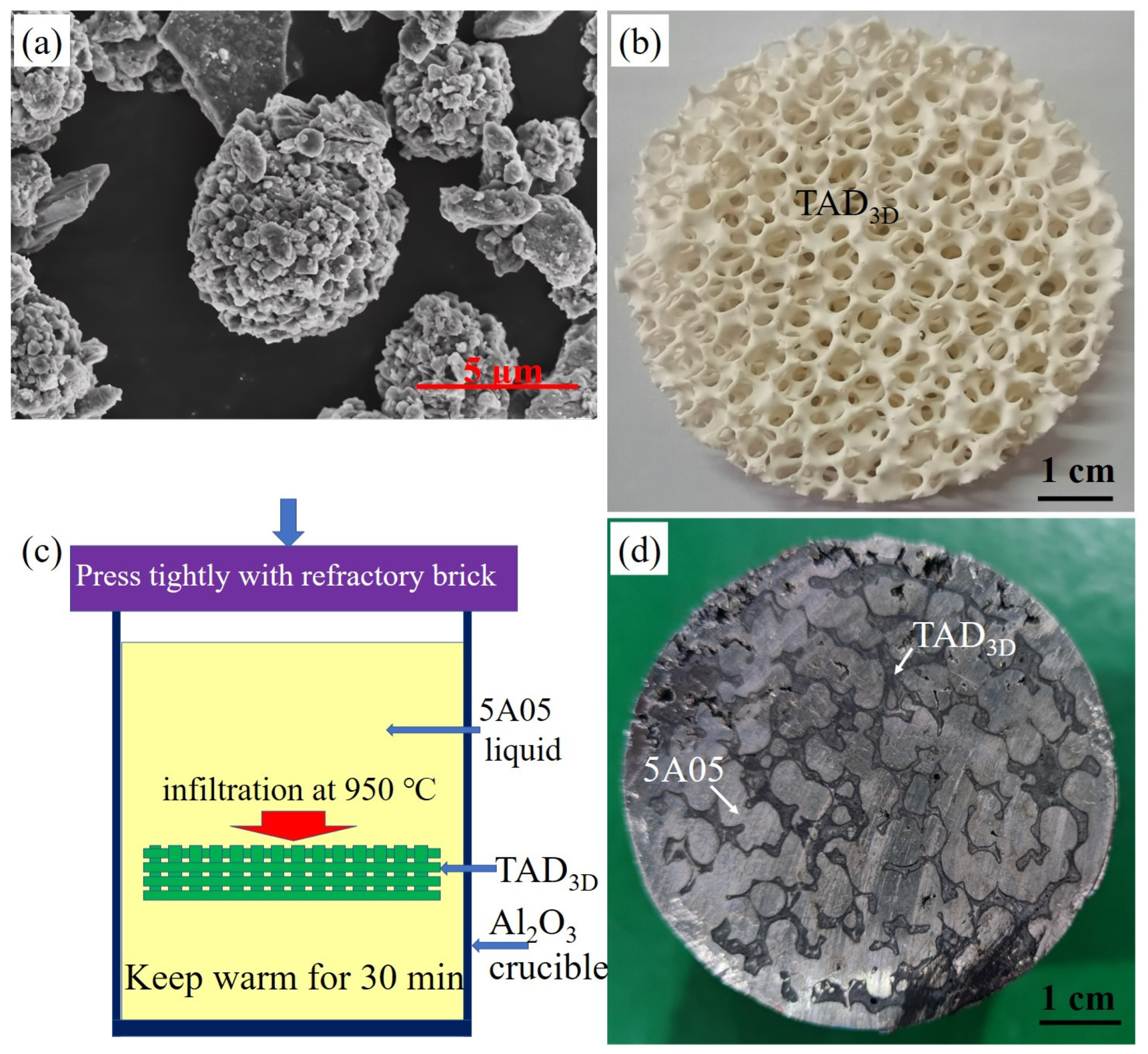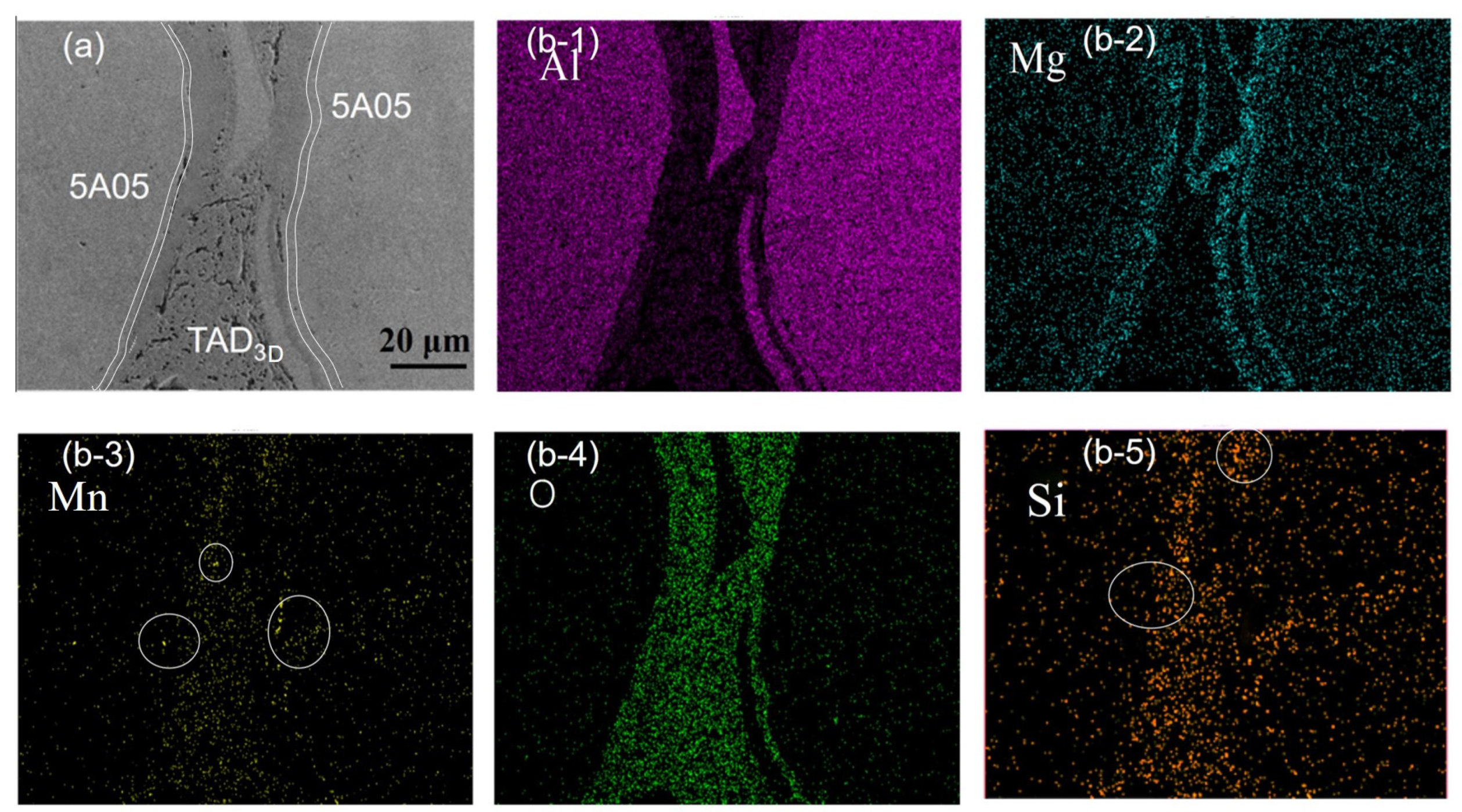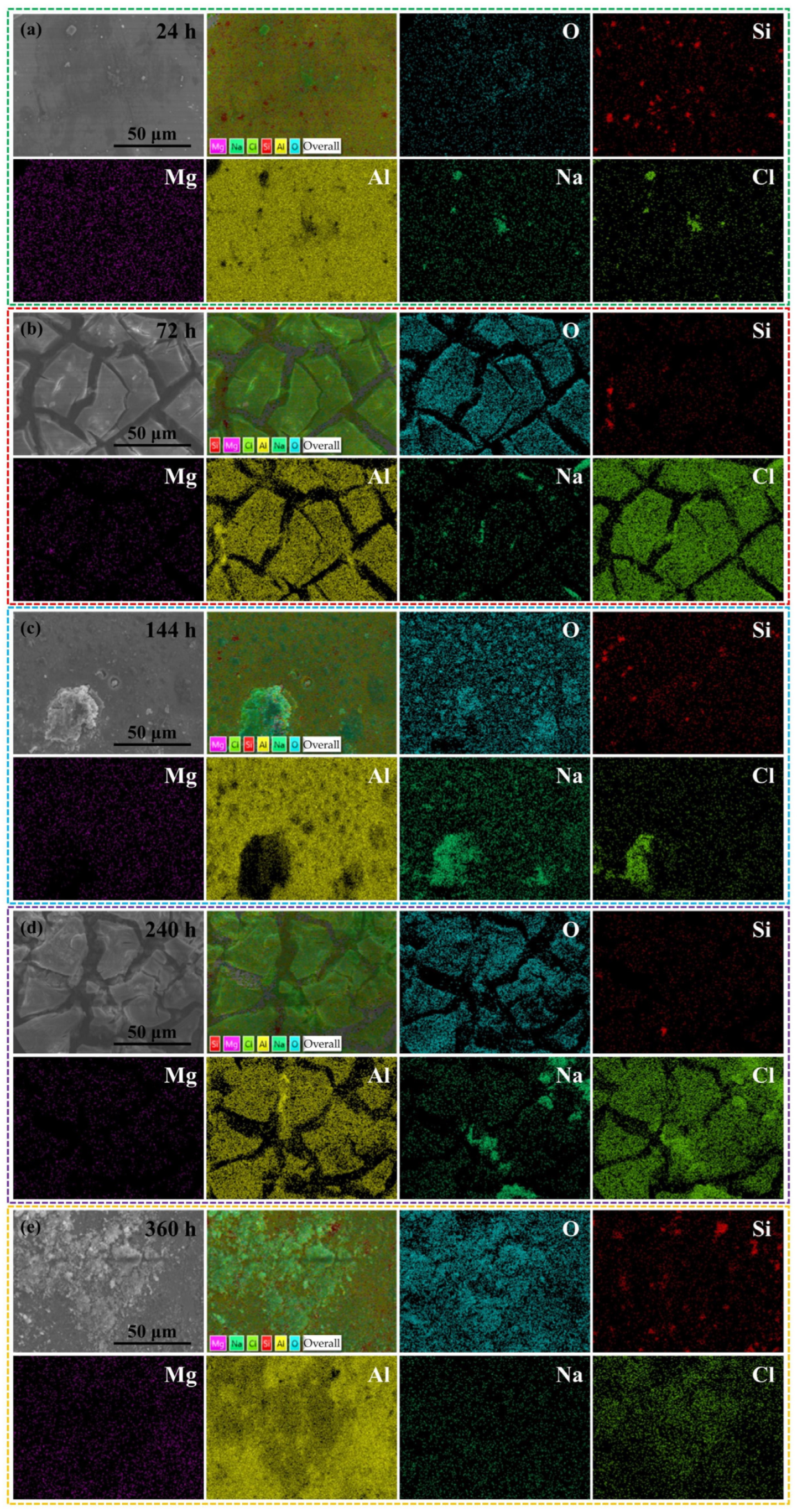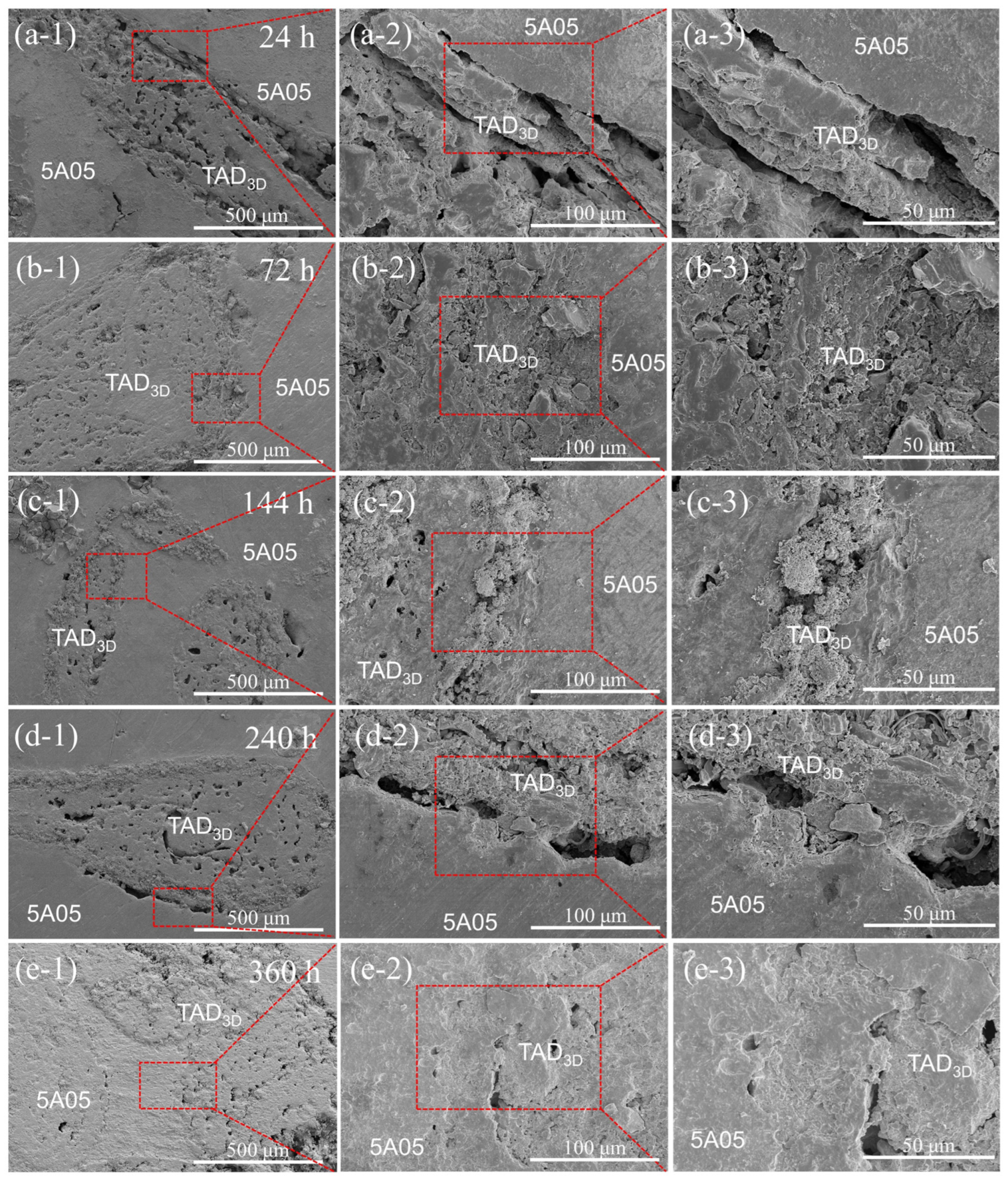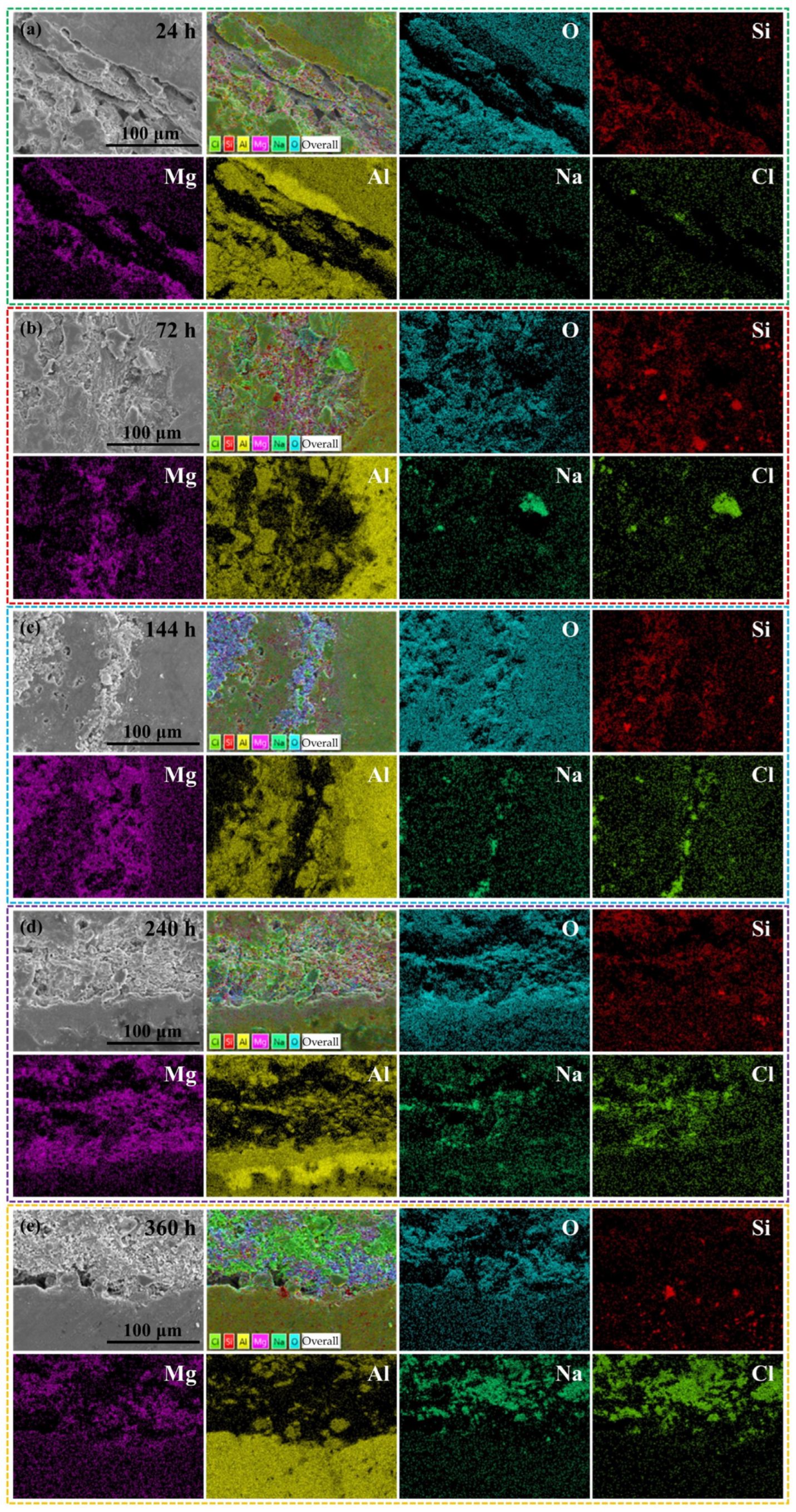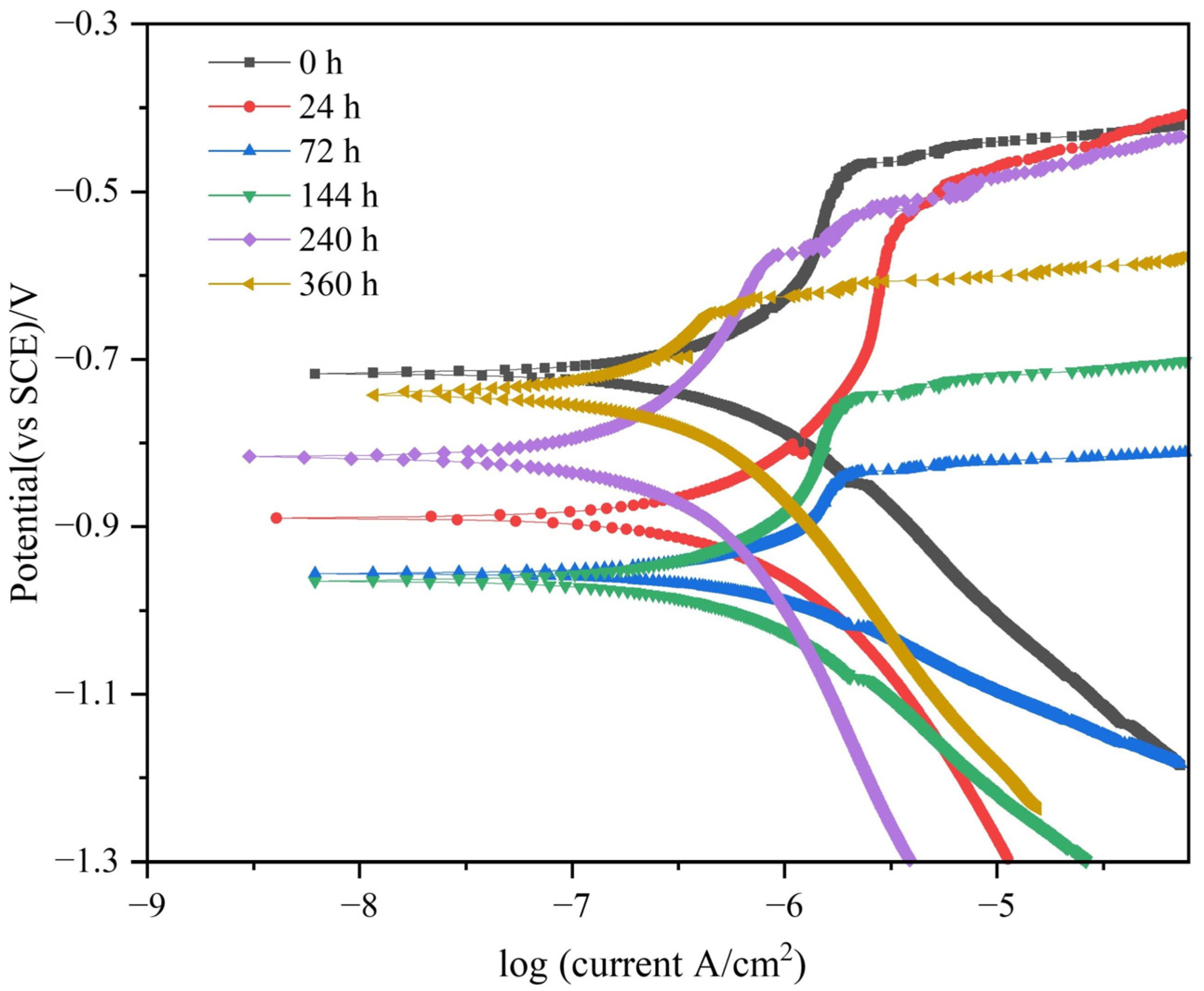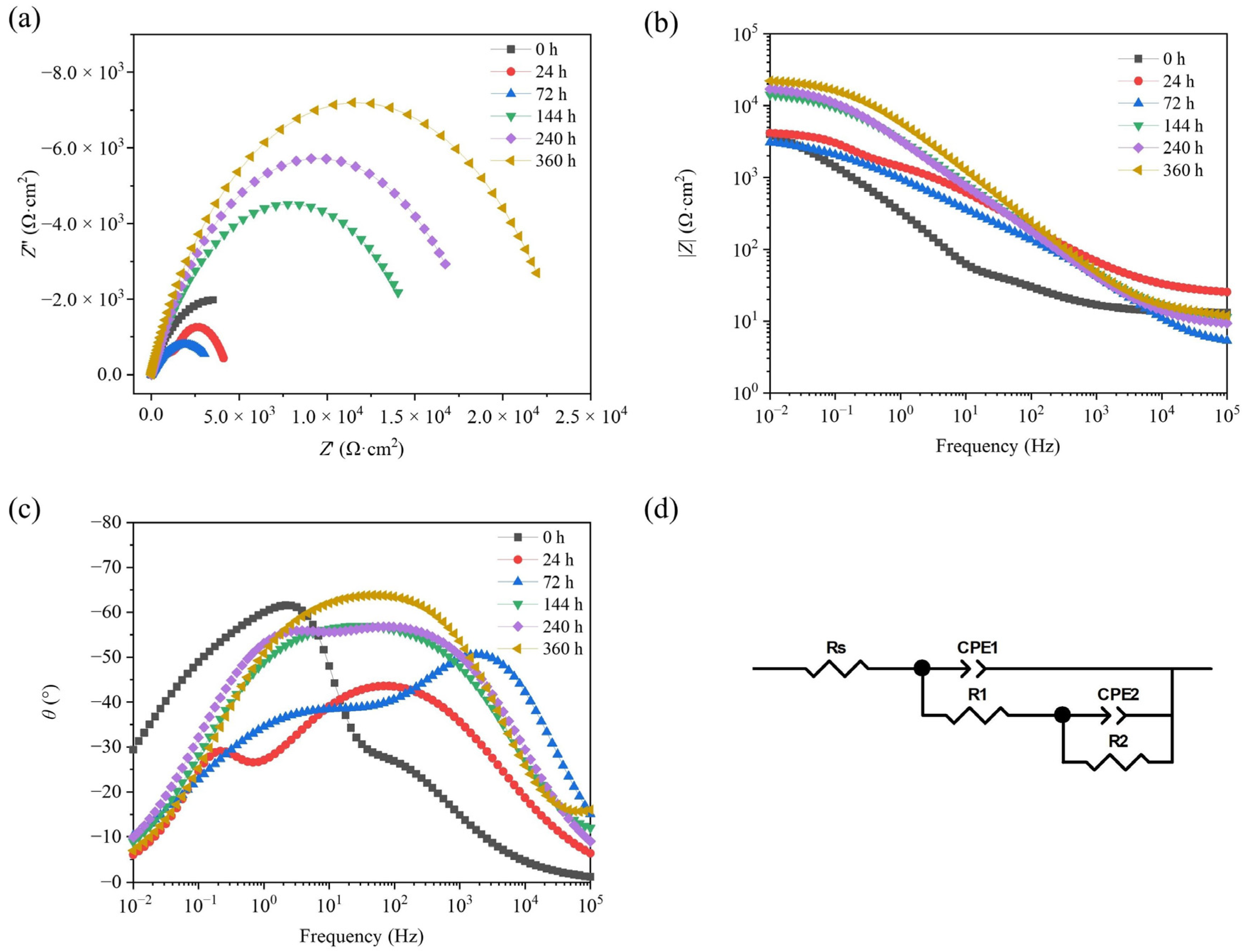3.1. Microstructure of TAD3D/5A05Al
Figure 1 depicts the raw materials, process schematic, and sample photos for the preparation of TAD
3D/5A05Al composite material. In
Figure 1a, an SEM image of the treated aluminum dross is shown, revealing its spherical shape. The sintered TAD
3D framework is shown in
Figure 1b, with a shrinkage rate of approximately 18% after sintering the green body. The framework appears yellowish-white, indicating successful sintering into ceramics; it exhibits a measured compressive strength of around 2–5 MPa, and a pore size of approximately 10 ppi.
Figure 1c illustrates the schematic of the pressureless infiltration process, where the TAD
3D framework guides the molten 5A05Al alloy, effectively expelling fine air bubbles between the framework and the 5A05Al solution, preventing defects in the internal structure of the composite material and reducing internal stresses during the preparation process. The samples of TAD
3D/5A05Al composite material exhibit a reflective silver-white luster and produce a solid tapping sound when cut to obtain test specimens, as shown in
Figure 1d. On the smooth surface, gray streaks represent the framework, while the silver-white metallic luster corresponds to the 5A05Al alloy. The TAD
3D framework has good affinity and wetting properties with the 5A05Al alloy, resulting in a dense interface and strong interfacial bonding. The samples of TAD
3D/5A05Al composite material exhibit a reflective silver-white luster and produce a solid tapping sound when cut to obtain test specimens, as shown in
Figure 1d. On the smooth surface, gray streaks represent the framework, while the silver-white metallic luster corresponds to the 5A05Al alloy. The TAD
3D framework exhibits excellent wetting properties with the 5A05Al alloy solution, and a dense bond is formed at the interface between TAD
3D and 5A05Al, resulting in high bonding strength.
Figure 2 illustrates the microstructure of the non-corroded TAD
3D/5A05Al composite material. In
Figure 2a-1, the microstructure of TAD
3D in the composite material is shown.
Figure 2a-2 is an enlarged view of
Figure 2a-1, revealing that the pores in the ceramic phase are completely filled by the 5A05 aluminum alloy. TAD
3D, manufactured by the polyurethane foam template method, contains triangular voids left by the combustion of polyurethane foam. In this study, the pressureless infiltration method was used to completely fill the triangular voids in TAD
3D with the 5A05Al solution, achieving a dense IPC structure between the 5A05Al alloy and TAD
3D, significantly enhancing the mechanical and corrosion resistance properties of TAD
3D/5A05Al. In
Figure 2a-2, the crystal boundaries and intra-crystalline regions of 5A05Al within the triangular voids are clearly visible, showing numerous second-phase particles, including the β-phase Mg
5Al
8, Mg
2Si, and (FeMn)Al
6. In 5A05 aluminum alloy, Si and Mg react to form Mg
2Si according to Equation (1), while Al and Mg react to produce the β-phase Mg
5Al
8 according to Equation (2). The coarse needle-like or plate-like AlMnMgSi phase, generated by the elements Al, Mn, Mg, and Si, represents a non-equilibrium solidification microstructure [
22].
Figure 2b-1,b-2 depicts the microstructure of 5A05Al, revealing that the α-Al grains of 5A05Al contain relatively fewer second-phase particles such as Mg
2Si, β-phase Mg
5Al
8, and (FeMn)Al
6. The Mg
2Si grains are small, approximately 3 μm, while Mg
5Al
8 is around 3 μm, Mg
2Si is approximately 30 μm, and (FeMn)Al
6 is about 15 μm.
Figure 2c-1,c-2 shows the microstructure of the interface between TAD
3D and 5A05Al alloy. The interface between the 5A05Al alloy and TAD
3D is clear, with a tight bond. At the interface, the quantity of second-phase particles, including Mg2Si, Mg
5Al
8, and (FeMn)Al
6, increases, and the Mg
2Si precipitates become coarser, forming a Chinese character pattern. Due to the different solubility of alloy elements in solid and liquid phases, elements such as Si, Mg, Fe, Mn in the 5A05 aluminum alloy tend to segregate into the liquid around the dendritic arms. Segregation alters the local thermodynamics of the alloy, providing a driving force for the formation of a second phase in the interdendritic region. Therefore, the second-phase particles, including Mg
2Si, Mg
5Al
8, and (FeMn)Al
6, increase in the interface between the alloy and the TAD
3D.
By complementing the TAD3D ceramic network and 5A05A with their own advantages, the TAD3D/5A05Al composite can provide the desirable mechanical properties including high specific stiffness, high plastic flow strength, creep resistance, good oxidation, and corrosion resistance.
Figure 3 depicts SEM and EDS surface scan images of the non-corroded composite material. The dense interface between the 5A05Al alloy and TAD
3D in the composite material is clearly visible. An interface layer, corroded by the etching solution, can be observed between TAD
3D and the 5A05Al matrix, as indicated by the white dashed line in
Figure 3a, with a thickness of approximately 4 μm. The EDS analysis of
Figure 3b-1–b-5 indicates that the 5A05Al alloy is mainly composed of Al, Mn, Mg, and Si elements. Mg diffuses from the 5A05Al matrix to TAD
3D and accumulates in TAD
3D. The distribution of O elements in the 5A05Al matrix is uniform, while in TAD
3D, it exhibits enrichment. Mg and Si elements form granular Mg
2Si phases and excess Si particles. Si elements in the 5A05Al matrix precipitate in small amounts, exhibiting a punctate aggregation. Mg and Al elements form Mg
5Al
8 phases, and Fe, Mn, Al, and other elements form (FeMn)Al
6 phases in TAD
3D. TAD
3D/5A05Al exhibits a slender network distribution of precipitated Mg
2Si [
23].
3.2. Microstructure of the Composite Material with NSS Corrosion Products
Figure 4 presents SEM images of the corroded surface of TAD
3D/5A05 composite materials after NSS corrosion for 24 h, 72 h, 144 h, 240 h, and 360 h, respectively.
Figure 4a-1–a-3 reveal that after 24 h of NSS corrosion, there are relatively few pitting corrosion pits on the metal surface at the interface between TAD
3D and 5A05Al. Pitting corrosion in the 5A05Al matrix generates, expands, and connects with each other, forming larger pitting corrosion pits. The corrosion products of 5A05 aluminum alloy increase, forming sheet-like accumulations on the corroded surface.
Figure 4b-1–b-3 illustrates that after 72 h of NSS corrosion, corrosion products are generated on the surface of the 5A05Al matrix, accompanied by the formation of a passive film. Cracks are observed on the passive film, exhibiting a relatively uniform pattern with a length of approximately 50 μm and a width of about 5 μm. The cracks create an oxygen-deficient zone, where Cl
− accumulates in the solution, leading to a different metal surface state inside the cracks compared to the exterior. The solution inside the cracks transitions from neutral to acidic, resulting in crevice corrosion in these areas.
Figure 4c-1–c-3 illustrates the condition of pitting corrosion on the 5A05Al matrix after 144 h of NSS corrosion. The diameters of these pitting pits have expanded laterally, increasing from 1 μm to 5 μm, with simultaneous growth in depth and area. The increased adsorption of Cl
− on the 5A05Al matrix results in the formation of more pitting pits on the surface. These pits expand, leading to the merging of multiple small pitting pits into larger ones. Some large pitting pits retain a small amount of residual corrosion products.
Figure 4d-1–d-3 show that after 240 h of NSS corrosion, a secondary reaction occurs on the 5A05Al matrix, leading to the formation of an aluminum oxide film [
24], which enhances the passivation performance of the metal, resulting in improved corrosion resistance. Destructive separation behavior due to crevice corrosion is prevented.
Figure 4e-1–e-3 reveal that after 360 h of NSS corrosion, the larger pitting corrosion sites on the corroded sample surface are covered by corrosion products, leading to self-healing of the corroded surface and a significant enhancement in corrosion resistance [
25]. We preliminarily believe that the reason for self-healing is that TAD
3D sintered from aluminum dross has strong hydration reaction ability. TAD
3D reacts with water to form aluminum hydroxide gel with high strength. At the same time, MgAl
2O
4, Al(OH)
3, and Al
2O
3 are filled in the gaps between TAD
3D and 5A05, as well as in the pitting pits on the surface, and together with the TAD
3D skeleton embedded in 5A05Al, form a dense and sturdy passivation film. This results in a self-healing phenomenon at the interface of composite materials, enhancing their corrosion resistance.
Figure 5 presents the EDS analysis results of TAD
3D/5A05 after NSS corrosion for 24 h, 72 h, 144 h, 240 h, and 360 h. EDS analysis results after 24 h of NSS corrosion presented in
Figure 5a indicate that the main components of the corrosion products are O, Si, Mg, Al, Na, and Cl, suggesting that the corrosion product is Al(OH)
3 [
23]. The uniformly distributed O element on the 5A05Al matrix reacts with H and Al according to Equation (3) to produce Al(OH)
3.
Figure 5b presents the EDS analysis results after 72 h of NSS corrosion, indicating that the corrosion products are Al(OH)
3 or corrosion products containing Mg. The morphology of the corrosion products is crack-like, and this feature is formed by the continuous generation of corrosion products in the active corrosion zone, gradually spreading and diffusing towards the surrounding area [
26]. EDS analysis of the corrosion products indicates that the main elemental components in the corrosion products are Al, O, Cl, Mg, and Si. Due to the presence of interface reaction products and defects at the interface of TAD
3D and the 5A05Al matrix, it becomes an active site. The Al matrix, as the anodic region, undergoes dissolution reactions first, forming Al
3+ and releasing electrons, while the cathodic region undergoes oxygen absorption reactions forming OH
−. The electrochemical reactions are shown in Equations (4) and (5).
Some of the Al
3+ in the solution reacts with OH
− to generate Al(OH)
3, and it can further react to form Al
2O
3 through Equation (6).
The formation of Al(OH)3 and Al2O3 through reactions has elevated the corrosion potential of the composite material, reducing the corrosion rate.
Figure 5c shows the EDS analysis results after 144 h, indicating the adsorption of Na
+ and Cl
− ions at the interface, and some pitting corrosion extending to the interface between TAD
3D and 5A05Al. The pitting corrosion is significantly deepened compared to NSS corrosion at 72 h, and the pits on the metal matrix develop into larger cracks, causing damage to the interface. At this point, corrosion intensifies [
27].
Figure 5d shows the NSS corrosion for 240 h. EDS analysis of the corrosion products inside the pitting reveals that the predominant components are O and a small amount of Al, with overlapping states of the corrosion product Al(OH)
3. Compared to 144 h, the number of cracks on the metal matrix surface decreases, and the corrosion behavior at the interface is mainly characterized by the healing of small cracks on the passivation film [
28]. With the extension of NSS exposure, the oxide film on the metal surface gradually thins. Cl
− reacts directly with 5A05Al through tiny pores in the oxide film, forming a gray-white corrosion product AlCl
3. Therefore, it can be inferred that the corrosion products mainly consist of Al(OH)
3, Al
2O
3, and AlCl
3.
Figure 5e shows NSS corrosion after 360 h, where some pits on the surface of the 5A05Al matrix are covered by corrosion products, improving the corrosion resistance of the material. EDS analysis of the corrosion products at the interface indicates the presence of O, Al, and Mg, suggesting the existence of MgAl
2O
4 spinel in the corrosion products. The corrosion products MgAl
2O
4, Al(OH)
3, Al
2O
3, and AlCl
3 adsorb at the interface, generating an oxide film along with the TAD
3D ceramic phase. This oxide film serves as an insulating barrier, restricting the inward diffusion of corrosive substances (such as ions or moisture) into the Al alloy matrix. It demonstrates a synergistic effect resulting from the combination of TAD
3D and 5A05Al in IPC composite materials, forming a stronger and more resistant passive layer that enhances the corrosion resistance of the composite material.
3.3. Microstructure of the Composite Material after Removal of NSS Corrosion Products
SEM images in
Figure 6 reveal the microstructure of the TAD
3D/5A05Al interface after corrosion removal. To observe fine details, the interface is magnified.
Figure 6a-1–a-3 depicts the microstructure after 24 h of NSS corrosion, showing pitting on the surface of the 5A05Al alloy, with pit sizes ranging from 2 μm to 8 μm, and minor corrosion.
Figure 6b-1–b-3 displays the microstructure after 72 h of NSS corrosion. Compared to
Figure 6a-1–a-3, the pits deepen, cracks with lengths of 10 μm to 20 μm appear inside the pits, cracks extend outward from the pits, and a small amount of aluminum oxide film peels off.
Figure 6c-1–c-3 shows the microstructure after 144 h of NSS corrosion, revealing widespread pitting on the material surface, with fine cracks of lengths ranging from 20 μm to 80 μm on the pits. Some areas of the 5A05Al matrix are covered by corrosion products, while others are exposed again, indicating a decrease in corrosion resistance with extended NSS time.
Figure 6d-1–d-3 reveals the microstructure after 240 h of NSS corrosion, showing a small number of pits on the metal surface covered by aluminum oxide. Compared to 144 h, some corrosion healing occurs in the passive film.
Figure 6e-1–e-3 shows the microstructure after 360 h of NSS corrosion, where the 5A05Al matrix generates a large amount of MgAl
2O
4, Al(OH)
3, and Al
2O
3. These aluminum oxides, along with the TAD
3D framework, form a dense corrosion product film, exhibiting a self-healing phenomenon in the composite material and enhancing corrosion resistance.
Figure 7 shows the EDS surface scan results of the TAD
3D/5A05Al interface after corrosion removal, allowing the determination of the chemical composition of the corroded surface of the sample.
Figure 7a displays the EDS results after 24 h of NSS corrosion, indicating that the corrosion product is primarily composed of O, Si, Mg, Na, and Al elements. This corresponds to the corrosion-generated Al(OH)
3 in the pits at the crack locations, causing minor damage to the passive film. The precipitated corrosion product is Al(OH)
3 or corrosion-generated phases containing Al.
Figure 7b presents the EDS results after 72 h of NSS corrosion, indicating a higher content of Mg elements on the exposed matrix, suggesting the breakdown of the passive film. Compared to 5A05Al, the anodic oxidation of the β-phase Mg
5Al
8 leads to a higher sensitivity to the nucleation of early pitting micropores. Therefore, pits are formed in 5A05Al, and residual Na and Cl elements aggregate within these micropores.
Figure 7c presents the EDS results after 144 h of NSS corrosion, indicating that the surface product Al(OH)
3 decomposes into aluminum oxides. Precipitated phases like Mg
2Si and Si particles preferentially precipitate at grain boundaries, leading to the depletion of solute atoms in the 5A05Al matrix near the grain boundaries, forming precipitate-free zones (PFZs) on both sides along the grain boundaries. Since atoms like Si and Mn usually have higher potentials, they act as cathodes in the corrosion microcells. The precipitated phases exhibit a continuous distribution along the grain boundaries, forming a continuous cathode, while the PFZs formed near the precipitated phases are approximated as Al. Aluminum, with generally lower potential, acts as an anode in the corrosion microcell. Consequently, the PFZs can be rapidly dissolved in this corrosion microcell, resulting in corrosion [
29]. The areas where the oxide film is damaged act as anodic sites in the active state, while those undamaged maintain a passive state as cathodic sites, forming an active–passive corrosion cell. The oxidation-reduction reactions cause metal dissolution within the pores to maintain internal electrical neutrality. Cl
− migrates into the pores, lowering the pH. Under the influence of H
+ and Cl
−, the metal is in an active state, leading to the formation of an active (inside the pore)–passive (outside the pore) corrosion cell. The increased migration of Cl
− and the decreased pH promote corrosion.
Figure 7d shows the EDS results after 240 h of NSS corrosion, indicating that the thin layer of interface reaction products formed at the interface of TAD
3D and 5A05.
Figure 7e shows the EDS results after 360 h of NSS corrosion, indicating that the corrosion products at the interface are primarily composed of O and Al. The corrosion products of the TAD
3D/5A05Al composite material are mainly aluminum metal corrosion products. The corrosion products exhibit a point-like distribution, adsorbing at the interface between the TAD skeleton and the Al matrix, forming a dense surface oxide layer. The Al
2O
3 in the passive layer is largely an insulator for electron conduction, hindering localized corrosion and preventing the formation and expansion of corrosion-related defects such as pitting and cracks. The interpenetrating phase structure of IPC composite materials enhances the stability of the microstructure and improves overall corrosion resistance by forming a protective oxide layer.
Therefore, the NSS corrosion from 24 h to 360 h experienced processes of pitting corrosion and crevice corrosion. Self-healing of the passivation film became apparent at 240 h of corrosion, and at 360 h, the self-healing phenomenon was pronounced. This aligns with the conclusions drawn from SEM and EDS observations in
Figure 4 and
Figure 5.
3.4. Electrochemical Test Results of the Composite Material at Different NSS Corrosion Durations
Figure 8 depicts the PDP curves of TAD
3D/5A05Al at different times after NSS. It can be observed that the PDP trends of TAD
3D/5A05Al are consistent at different times after NSS. The
Ecorr and
Icorr values can be obtained from the PDP curve for
Table 3. The
Ecorr value serves as a thermodynamic criterion for the corrosion resistance of the composite material; a higher
Ecorr value indicates stronger corrosion resistance, while a lower
Ecorr value suggests weaker corrosion resistance [
30]. From
Table 3, it can be seen that as the NSS corrosion time increases from 0 to 144 h, the
Ecorr value decreases. After 144 h of NSS corrosion,
Ecorr decreases to the minimum value of −0.971 V, indicating that the passive film is damaged, the corrosion voltage decreases, and the corrosion resistance reaches its lowest point. From 240 h to 360 h of NSS corrosion, the
Ecorr value increases. After 360 h of NSS corrosion,
Ecorr increases to −0.786 V, slightly lower than the
Ecorr value of the uncorroded sample (−0.718 V). This indicates that after 240 h of NSS, a large amount of corrosion products is formed on the surface of the composite material, protecting it. The corrosion voltage increases, the corrosion rate decreases, and the corrosion resistance improves. When NSS reaches 360 h, a complete corrosion product film forms on the surface. The corrosion voltage continues to increase, playing a suppressive role in corrosion, and enhancing corrosion resistance.
Icorr can serve as a dynamic criterion for the corrosion resistance of composite materials. A higher
Icorr value indicates weaker corrosion resistance, while a lower
Icorr value indicates stronger corrosion resistance. The trend of
Icorr changes in
Table 3 is also used to assess the corrosion resistance of the composite material, and the pattern is similar to that of
Ecorr. As the NSS corrosion time increases from 0 to 144 h, the
Icorr value increases. After 144 h of NSS corrosion,
Icorr increases to the maximum value of 0.692 µA·cm
−2, indicating that the passive film is damaged, the corrosion current is at its maximum, the corrosion rate increases, and the corrosion resistance reaches its lowest point. From 240 to 360 h of NSS corrosion, the
Icorr value decreases. After 240 h of NSS corrosion,
Icorr decreases to 0.178 µA·cm
−2, which is already lower than the
Icorr value of the uncorroded sample (0.398 µA·cm
−2). After 360 h of NSS corrosion,
Icorr decreases to 0.141 µA·cm
−2, lower than the
Icorr value of the uncorroded sample. After 240 h of NSS, the composite material’s surface begins to generate a large amount of corrosion products, providing protection. The corrosion current decreases, corrosion rate decreases, and corrosion resistance enhances. When NSS reaches 360 h, a complete corrosion product film forms on the surface, further reducing the corrosion current, suppressing corrosion, decreasing the corrosion rate, and improving corrosion resistance. Additionally, after NSS treatment, a dense oxide film forms on the surface of the TAD
3D/5A05Al composite, increasing the anodic Tafel slope and decreasing the cathodic Tafel slope. This indicates that the presence of the oxide film alters the corrosion reaction kinetics of the aluminum alloy, reducing the rates of cathodic and anodic reactions.
Figure 9 shows the fitted results of EIS tests on TAD
3D/5A05Al with corroded products after different NSS durations.
Figure 9a shows the Nyquist plot of TAD
3D/5A05Al, indicating a trend of decreasing and then increasing high-frequency arc radius with increasing NSS time. Since the arc radius is proportional to corrosion resistance, the corrosion resistance decreases and then increases with increasing NSS time. This is because the presence of O
2 in the solution promotes the formation of the passive film on the surface of the 5A05Al alloy, but the film formation rate is slow in the early stages. Once a complete corrosion product film is formed, corrosion resistance begins to increase.
Figure 9b,c depict the Bode plots of TAD
3D/5A05Al. The impedance values of samples at different NSS times in the Bode plots exhibit a trend of initially decreasing and then increasing, consistent with the results from PDP. After NSS for 24 h, TAD
3D/5A05Al is under the protection of a passive film, exhibiting excellent corrosion resistance. Between NSS 72 h and 144 h, with the increasing NSS time, the arc radius decreases, the peak value of the phase angle in the low-frequency region decreases, the height of the phase angle peak in the high-frequency region decreases, and its width narrows. Additionally, the slope of log
f versus |
Z| modulus decreases, and the impedance modulus value decreases [
31]. All these indicate that the electrode is in the anodic dissolution stage, and the corrosion activity on the electrode surface becomes more intense. This suggests that the passive film of TAD
3D/5A05Al is damaged, leading to a reduction in corrosion resistance. The sample corroded for 144 h. It is possible that, although the corrosion current is still high and the corrosion potential is still low, the passivation film of the composite material has begun to form; moreover, EIS shows an increase in the obstruction of the composite. After NSS for 240 h, there are more corrosion products on the 5A05Al alloy. Corrosion products such as MgAl
2O
4, Al(OH)
3, Al
2O
3, and AlCl
3 adsorb at the interface and, together with TAD
3D ceramics, form a protective oxide film, reducing the unevenness of the microelectrochemical environment and the pitting sensitivity on the surface of the composite material. The corrosion process of the composite material involves the inhibition of both anodic dissolution and cathodic depolarization reactions. Due to the abundant corrosion products and their rapid generation, approaching or exceeding the diffusion rate, the arc radius increases. The peak value of the phase angle in the low-frequency region increases, and its width widens. The slope of log
f versus |
Z| modulus increases, and the impedance modulus value increases. All these indicate that the corrosion resistance begins to enhance. By NSS 360 h, the low-frequency impedance modulus value increases, the arc radius begins to increase, and the peak phase angle region widens. This indicates a steady improvement in the corrosion resistance of TAD
3D/5A05Al, as the surface corrosion products are most abundant and dense, and the surface passivation film is fully formed, achieving optimal corrosion resistance.
Figure 9d illustrates the equivalent circuit diagram used during the fitting process. By analyzing the EIS spectra, it can be concluded that all the curves exhibited two capacitive loops. It can be assumed that overall response of the system is associated with (
R1–
CPE1) loop owing to the formation of film on the alloy surface and (
R2–
CPE2) loop due to the double layer formed at metal–solution interface. Among them, Rs is the resistance of the electrolyte,
CPE1 is the oxide film capacitance,
R1 is the oxide film resistance,
CPE2 is the double-layer capacitance, and
R2 is the charge transfer resistance. The 1st loop (
R1–
CPE1) encompasses all the information related to the surface layer and the possible defects that may be present within it. The EIS results were analyzed with the ZView program using the equivalent circuit shown in
Figure 9d, and the values of the parameters obtained are tabulated in
Table 4.
From
Table 4, it can be observed that the solution resistance (
Rs) remained constant. The results showed that the increases in impedance values were strongly linked by the values of
R1 and
R2. Further, a slight deviation from typical capacitive behavior at high frequencies, possibly due to uneven oxide film formation on the metal matrix. With different times of NSS corrosion treatment, the
R2 value of the TAD
3D/5A05Al increases. Without NSS, the
R2 value of the sample is the lowest, at 7.30 × 10
3 Ω·cm
2. After NSS 360 h, the
R2 value of the sample is the highest, at 2.40 × 10
4 Ω·cm
2.
R1 and
R2 play a decisive role in the impedance value of the sample, and compared to the values of
R1 and
R2, the
Rs value can be basically ignored.
It is worth noting that the presence of the second phase/interface phase typically disrupts the continuity of the passivation film, and the vicinity of the second phase/interface phase often becomes a weak point in the passivation film. The presence of corrosive ions, especially Cl ions, can lead to the rupture of the passivation film, thereby triggering galvanic corrosion/pitting initiation. Specifically, the presence of Mg in 5A05Al can reduce the surface tension of the Al liquid and the surface energy between the Al liquid and TAD3D, improving the wetting properties between them. This enables the preparation of composite materials with lower porosity and higher density, indirectly suppressing the direct interface reaction between TAD3D and Al liquid and the formation of harmful interface reaction phases. Meanwhile, electrochemical tests indicate that factors such as lower interface corrosion resistance or a relatively weak passivation film at the interface do not significantly reduce the corrosion resistance of TAD3D and 5A05Al. This is because the TAD3D/5A05Al composite material has a unique IPC structure. The Mg in 5A05Al improves the wetting properties between the Al liquid and TAD3D and simultaneously forms a macroscopic interface composite with TAD3D. When immersed in a corrosive medium containing ions, before the formation of a chemical oxidation film, oxygen and electrons freely diffuse and migrate at the interface between the solution and the metal. Therefore, the anodic and cathodic corrosion rates of TAD3D/5A05Al are relatively high. After the formation of the chemical oxidation film, this uniformly dense film hinders the diffusion and migration of O2 and electrons between the solution and the metal interface, suppressing both anodic and cathodic reactions. As a result, the corrosion resistance of the aluminum alloy is improved, ensuring that the overall corrosion resistance of the composite material is not reduced. This is consistent with the microscopic morphology of the oxide film observed by SEM and EDS chemical composition analysis.
